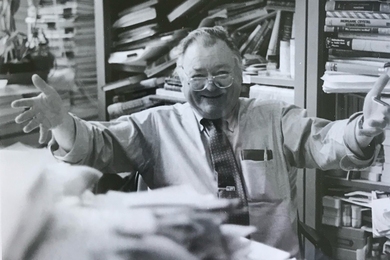MIT researchers are working with a flight simulator at the nearby Volpe National Transportation Systems Center to develop improved methods for pilots to navigate the skies.
The Transportation Human Factors Laboratory at Volpe was created in the fall of 1991 as a result of a cooperative research and development agreement between Volpe and MIT's Center for Transportation Studies. Volpe's Frasca flight simulator, which emulates light twin-engine aircraft used by general aviation, is being used to develop advanced cockpit displays for GPS (global positioning system) navigation in order to improve pilot performance, reduce workload and improve safety. Research is funded by the Federal Aviation Administration through Volpe's Cockpit Human Factors Program.
GPS receivers in aircraft use satellite signals to determine the aircraft position, ground speed and altitude much more precisely than the technology now in use. Currently, most airplanes use VOR (VHF omnidirectional radio range) equipment for en route navigation and as one of several decades-old methods for conducting landing approaches, explained Charles Oman, director of the Man Vehicle Laboratory in the Department of Aeronautics and Astronautics. In a precision approach using an ILS (instrument landing system), the plane gets both vertical and horizontal guidance information via radio signals from transmitters on the ground at the destination airport. The pilot maintains the correct course by keeping a pair of needles aligned in a cockpit display.
The other method used under somewhat better weather conditions employs only a horizontal signal, so the pilot must use the less accurate cockpit altimeter to gauge altitude. These positioning methods have drawbacks; VOR is accurate only to about five degrees, and the ground transmitters must be painstakingly checked and calibrated. "They are difficult and expensive things to maintain," Dr. Oman noted. Also, GPS can be used anywhere by an airplane with the proper equipment, whereas many smaller airports don't have ILS transmitters. "There are thousands of airports around the country that could suddenly become more accessible," he added.
GPS, which is already used in ocean navigation, uses signals from satellites to provide much more precise information to the pilot. The FAA hopes that work at the Volpe lab and elsewhere will result in GPS replacing both VOR and ILS relatively soon. "There's a lot of support from the user community, and the technology is ready," Dr. Oman said.
Dr. Oman, Dr. M. Stephen Huntley of Volpe and Scott Rasmussen, an aero/astro graduate student, are working on developing displays that can be easily adapted to existing cockpit hardware. Volpe researchers are also developing map and terrain avoidance displays, and human factors standards for receiver logic. Systems developed in the Volpe simulator are also evaluated in the real thing-a Piper Aztec airplane based in Bedford, MA, whose cockpit is similar to the flight simulator. Once the new system is installed in this airplane and others, pilots can test it while still using the old positioning methods as a backup.
So far, the MIT-Volpe team has demonstrated in the simulator that advanced displays which provide information on ground track angle error can improve initial and final approach performance. These initial results will be presented at the IFAC Conference on Man Machine Systems at MIT next month.
The Frasca flight simulator is not the only Transportation Human Factors Laboratory facility used by MIT researchers; there is also a high-speed train simulator that is the focus of research by Thomas Sheridan, professor of engineering and applied psychology who also has an appointment in aero/astro. It provides a computer-generated image of the track ahead of a moving train and provides a means of testing new on-board signal displays, since high-speed trains move too fast for train operators to see and react to traditional track signals, he explained.
A version of this article appeared in MIT Tech Talk on May 24, 1995.





